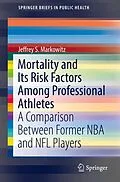Autorentext
Jeffrey S. Markowitz, DrPH, is an epidemiologist who has authored two books, Pigskin Crossroads: The Epidemiology of Concussions in the National Football League (NFL), 2010-2012 (2013), and Lost Seasons: Arrests, Suspensions, Career Chaos, and Mortality Among National Football League (NFL) Players (2016). From 1983 to 1992, Dr. Markowitz was an adjunct assistant professor of Public Health at the School of Public Health at Columbia University in New York, NY, USA.
Klappentext
Zusammenfassung
This eye-opening study adds to the scarce scholarly literature on professional athletes, bringing empirical rigor to issues often clouded by mystery and hearsay. It identifies socioeconomic, demographic, and career variables as risk factors for mortality among former NBA and NFL players, along with hypotheses to be tested relating to elite athletes and other U.S. populations. A detailed multivariate analysis compares mortality factors, rates, and outcomes within and between the two leagues, comparing them also with the general U.S. male population. The findings and conclusions gleaned from this research offer possibilities for future research to improve health and quality of life in this specific athlete cohort, among athletes in general, in other groups, and in the larger society.
Potential risk factors analyzed in this groundbreaking study:
· Race
· Body Mass Index (BMI)
· U.S. birthplace region (Northeast, West, Midwest, South)· Years of playing experience
· Playing position
Mortality and Its Risk Factors among Professional Athletes will spark interest among professionals and researchers in public health, sports medicine, and epidemiology; current and former NBA and NFL players, their families, coaches, trainers, and union representatives; non-professional basketball and football players, athletes from other sports, and their families, coaches, and trainers; social scientists; policymakers; obesity researchers; parents of children who play contact sports; students, teachers, and researchers in occupational health and racial disparities; and health care providers.
Inhalt
*Current chapter names are placeholders only and will be changed for the book
1. Introduction
There are three common factors that can impact on morbidity and mortality among worker groups. First, there are toxic environmental exposures like asbestos or coal dust that can lead to specific types of disease. Second, there are on-the-job dangers that may result in injuries or accidents. In the case of both toxic environmental exposures and injuries or accidents, immediate and/or delayed deleterious health responses can follow. Finally, there are selection factors related to certain occupations like body mass index (BMI), educational level, and lifestyle that may be related to morbidity and/or mortality.
As far as we know, there are not any issues in professional basketball or football with respect to exposure to toxic environmental hazards.
Leisure-time physical activity is thought to have health benefits for participants. When physical activities become competitive and significant physical contact is included in the scenario, the health benefits can become tainted by short- and even long-term injury and illness. In a violent game, like professional football, injuries include concussions and brain trauma that sometimes lead to long-term neurodegenerative illnesses like chronic traumatic encephalopathy (CTE) (Markowitz and Markowitz, 2013, see Chapter 3). While head and other serious injuries do occur in the NBA, no reports of CTE in former basketball players were identified.Selection factors can also impact on morbidity and mortality, both in the general population and among professional basketball and football players. For example:
- African-Americans live fewer years than whites within the general population (Arias, 2011; Woolf et al., 2004; Satcher et al., 2005), NBA players (Lawler et al., 2016), and NFL players. (Baron et al., 2012; Markowitz, 2016)
- People born in the southern part of the US live fewer years than individuals born in other US regions. (Centers for Disease Control and Prevention, 2014) The same is true for NFL players. (Markowitz, 2016)
- Obese BMI increases the risk of mortality in the general population (Flegal et al., 2005) as well as within NFL players. (Markowitz, 2016; Baron et al., 2012)
In general, less is known about potential risk factors for mortality among NBA players. In addition, mortality and risk factor comparisons have never been made between NBA and NFL players.
2. Literature Review
Three publications written by former National Institute of Occupational Safety and Health (NIOSH) researchers dominate the literature on mortality among former NFL players (Baron et al., 1994; Baron et al., 2012; Lehman et al., 2012). These papers added to existing knowledge at the time that they were written. However, the most recent of these papers is already ten years old and is outdated. In fact, the NIOSH papers only studied relatively young former NFL players (median age = 41 years in the 1994 paper, and 57 years in the two 2012 papers). Consequently, they include relatively small numbers of NFL player deaths (n = 103 and 334 respectively). Since the most recent NIOSH studies, there have been more than a thousand additional deaths among NFL players. Furthermore, the NIOSH studies had significant selection issues based on their sampling of only NFL players with five or more pension-credited playing seasons (from 1959 to 1988). The current book will study all former NFL players who played between 1960 and 1986, and will also study all former NBA players during these same years.